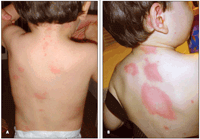Acute Urticaria
Circumscribed erythematous lesions developed on the back and abdomen of this 19-month-old boy. The rash was mildly pruritic. The parents gave the child 1 dose of diphenhydramine, and the rash resolved after an hour. About 12 hours later, new lesions developed on the face, neck, and upper back. The child was given the same treatment and the symptoms resolved. The following morning, widespread lesions were noted on the child's face, neck, trunk, and extremities.
Circumscribed erythematous lesions developed on the back and abdomen of this 19-month-old boy (A). The rash was mildly pruritic. The parents gave the child 1 dose of diphenhydramine, and the rash resolved after an hour. About 12 hours later, new lesions developed on the face, neck, and upper back (B). The child was given the same treatment and the symptoms resolved. The following morning, widespread lesions were noted on the child's face, neck, trunk, and extremities (C).
These recurrent lesions are characteristic of acute urticaria, which may manifest with multiple erythematous wheals anywhere on the body. The lesions can cause mild to intense pruritus. About 20% of the general population have had at least one episode of urticaria.

A cause may occasionally be identified in patients with acute urticaria. Medications, insect stings, foods, food additives, aeroallergens/contact allergens, transfusion reactions, and infections (viral, bacterial, fungal, and parasitic) are common causes. Less common causes of acute urticaria include collagen vascular diseases, malignancy, physical urticarias, hereditary diseases, urticaria pigmentosa, and hormone-associated urticaria.1
Infection, most commonly viral, accounts for 80% of acute urticaria cases in children.2 Hepatitis A and B viruses, Epstein-Barr virus, and HIV are well-documented viral causes of acute urticaria. Cytomegalovirus, herpes simplex virus type 1, influenza A virus, Parvovirus B19, and enterovirus have also been associated with acute urticaria.3 In a study of children aged 1 to 12 years who had acute urticaria, 90% had concurrent respiratory tract symptoms.3

This child did have nasal congestion and sneezing with no associated fever the day before the rash onset. He had no history of new food ingestions, detergents, clothing or diapers or other allergen exposure. Because the history and clinical findings did not suggest an underlying disease process, no further investigation was necessary. The rash had completely resolved 48 hours after its initial onset.
Acute urticaria flares are selflimited and do not require treatment. 4 Associated symptoms can be controlled with antihistamines, cool baths, cool compresses, or calamine lotion.4 Prednisone has also been used with some success in adults with acute urticaria, although its adverse effect profile may outweigh its benefits in this setting.5 One limited trial showed abatement of acute urticaria symptoms in children treated with oral prednisolone6; however, no existing studies have been designed to specifically evaluate the role of corticosteroids in the treatment of acute urticaria in children.
References:
REFERENCES:1. Atkinson NF Jr, Yunginger JW, Busse WW, et al, eds. Middleton's Allergy: Principles and Practice. 6th ed. Philadelphia: Mosby; 2009:1063-1081.
2. Mortureux P, Léauté-Labrèze C, Legrain-Lifermann V, et al. Acute urticaria in infancy and early childhood: a prospective study. Arch Dermatol. 1998;134:319-323.
3. Bilbao A, GarcÃa JM, Pocheville I, et al. Round table: urticaria in relation to infections [in Spanish]. Allergol Immunopathol (Madr). 1999;27:73-85.
4. Clarke P. Urticaria. Aust Fam Physician. 2004;33:501-503.
5. Pollack CV Jr, Romano TJ. Outpatient management of acute urticaria: the role of prednisone. Ann Emerg Med. 1995;26:547-551.
6. Zuberbier T, Iffländer J, Semmler C, Henz BM. Acute urticaria: clinical aspects and therapeutic responsiveness. Acta Derm Venereol. 1996;76:295-297.
Recognize & Refer: Hemangiomas in pediatrics
July 17th 2019Contemporary Pediatrics sits down exclusively with Sheila Fallon Friedlander, MD, a professor dermatology and pediatrics, to discuss the one key condition for which she believes community pediatricians should be especially aware-hemangiomas.